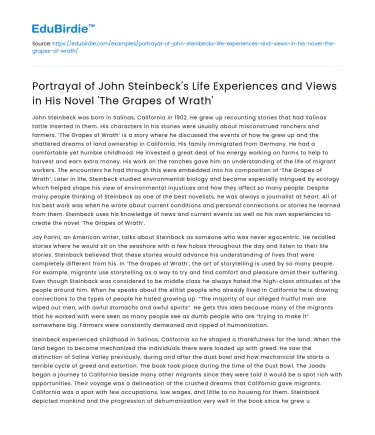John Steinbeck was born in Salinas, California in 1902. He grew up recounting stories that had Salinas tattle inserted in them. His characters in his stories were usually about misconstrued ranchers and farmers. ‘The Grapes of Wrath’ is a story where he discussed the events of how he grew up and the shattered dreams of land ownership in California. His family immigrated from Germany. He had a comfortable yet humble childhood. He invested a great deal of his energy working on farms to help to harvest and earn extra money. His work on the ranches gave him an understanding of the life of migrant workers. The encounters he had through this were embedded into his composition of ‘The Grapes of Wrath’. Later in life, Steinbeck studied environmental biology and became especially intrigued by ecology which helped shape his view of environmental injustices and how they affect so many people. Despite many people thinking of Steinbeck as one of the best novelists, he was always a journalist at heart. All of his best work was when he wrote about current conditions and personal connections or stories he learned from them. Steinbeck uses his knowledge of news and current events as well as his own experiences to create the novel ‘The Grapes of Wrath’.
Jay Parini, an American writer, talks about Steinback as someone who was never egocentric. He recalled stories where he would sit on the seashore with a few hobos throughout the day and listen to their life stories. Steinback believed that these stories would advance his understanding of lives that were completely different from his. In ‘The Grapes of Wrath’, the art of storytelling is used by so many people. For example, migrants use storytelling as a way to try and find comfort and pleasure amid their suffering. Even though Steinback was considered to be middle class he always hated the high-class attitudes of the people around him. When he speaks about the elitist people who already lived in California he is drawing connections to the types of people he hated growing up: “The majority of our alleged fruitful men are wiped out men, with awful stomachs and awful spirits”. He gets this idea because many of the migrants that he worked with were seen as many people see as dumb people who are “trying to make it” somewhere big. Farmers were constantly demeaned and ripped of humanization.
Save your time!
We can take care of your essay
- Proper editing and formatting
- Free revision, title page, and bibliography
- Flexible prices and money-back guarantee
Steinbeck experienced childhood in Salinas, California so he shaped a thankfulness for the land. When the land began to become mechanized the individuals there were loaded up with greed. He saw the distinction of Saline Valley previously, during and after the dust bowl and how mechanical life starts a terrible cycle of greed and extortion. The book took place during the time of the Dust Bowl. The Joads began a journey to California beside many other migrants since they were told it would be a spot rich with opportunities. Their voyage was a delineation of the crushed dreams that California gave migrants. California was a spot with few occupations, low wages, and little to no housing for them. Steinback depicted mankind and the progression of dehumanization very well in the book since he grew up around individuals who dealt with similar experiences. He believes that the individuals that could have helped migrants, Okies, or those who were less fortunate were brainwashed by the mechanical progression and institutional power. He saw the land as an automated, benefit hungry nature which thusly took the humanization from everybody included.
Due to the significant number of the issues that I have already talked about, Steinbeck took in the significance of family. His dad, John Ernst Steinbeck, was not an appallingly accomplished man. He was the chief of a Sperry flour plant, the proprietor of a feed and grain store, and the treasurer of Monterey County. However, he was constantly losing his job and trying to find new ones. despite his dad's many working disappointments, he realizes that his dad endeavoured to support and accommodate their family. In ‘The Grapes of Wrath’, this equivalent hopefulness is seen in Ma since she has a lot of love for her family. Even though she experiences numerous hardships she proceeds with the journey for the benefit of her family. Steinbeck's mom was a strong-willed woman. In ‘The Grapes of Wrath’ is set in a time where women are not treated as well as men. He writes about how the mistreatment of women makes them stronger because it teaches them to keep their composure and dignity. He had two older sisters, Esther and Beth, and a younger sister, Mary who he was always closer too. These are the people in his life that he recognizes will be there for him knows it is vital to remain associated with them. How he esteems his family looks are seen in the way family is defined in his novel.
Steinbeck utilizes his understanding of information and contemporary affairs as well as his personal experiences to create the novel ‘The Grapes of Wrath’. Steinback believed that these tales would develop his and others' appreciations of lives that had been unique from their own which is why he wrote from the perspectives of those who had a different existence from his. However, Steinbeck also included knowledge of the place he grew up and his household dynamics to structure many of the fundamental principles in his novel. For these reasons, Steinbeck is an exceptional journalist and annalist of the world around him, even today.






 Stuck on your essay?
Stuck on your essay?

